Kingdom Plantae Family Poaceae Tribe Triticeae | Order Poales Subfamily Pooideae Genus Triticum
L. | |
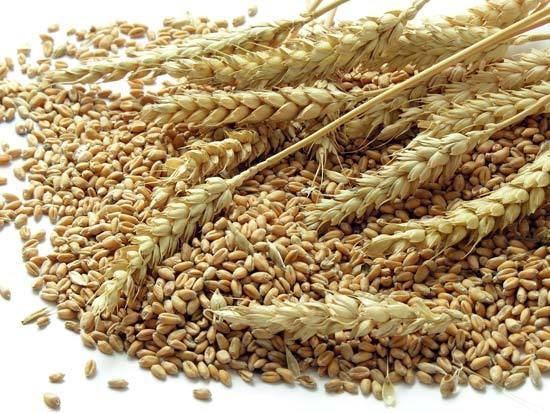 | ||
Similar Maize, Barley, Cereal, Rice, Flour | ||
Wheat (Triticum spp., most commonly T. aestivum) is a cereal grain (botanically, a type of fruit called a caryopsis), originally from the Levant region but now cultivated worldwide. In 2016, world production of wheat was 749 million tonnes, making it the second most-produced cereal after maize (1.03 billion tonnes), with more than rice (499 million tonnes). Since 1960, world production of wheat and other grain crops has tripled and is expected to grow further through the middle of the 21st Century.
Contents
- Why whole wheat
- Origin
- Farming techniques
- Genetics
- Plant breeding
- Hybrid wheat
- Hulled versus free threshing wheat
- Naming
- Major cultivated species of wheat
- Classes used in the United States
- As a food
- Nutrition
- Worldwide consumption
- Health effects
- Concerns
- Comparison with other staple foods
- Commercial use
- Production and consumption
- Historical factors
- Farming systems
- Geographical variation
- Most productive
- Futures contracts
- Crop development
- Diseases
- Pests
- References
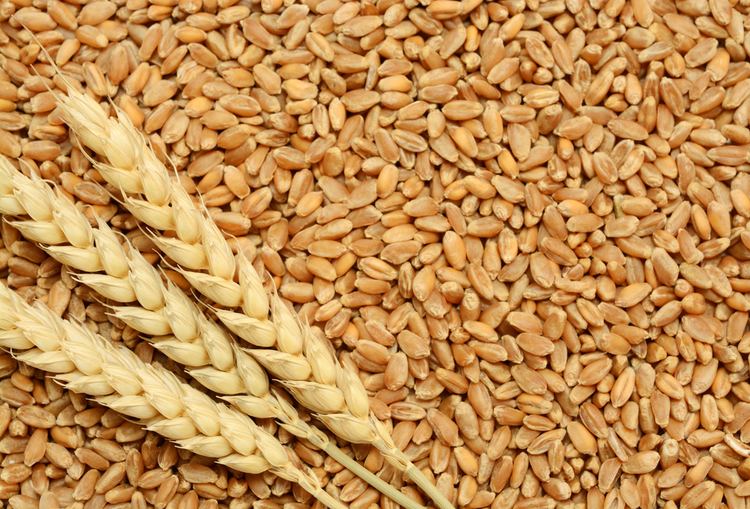
This grain is grown on more land area than any other commercial food (220.4 million hectares, 2014). World trade in wheat is greater than for all other crops combined. Globally, wheat is the leading source of vegetal protein in human food, having a protein content of about 13%, which is relatively high compared to other major cereals and staple foods. The archaeological record suggests that wheat was first cultivated in the regions of the Fertile Crescent around 9600 BCE.
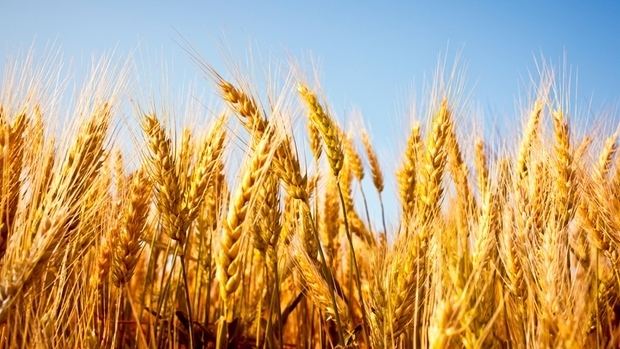
When eaten as the whole grain, wheat is a source of multiple nutrients and dietary fiber, and is associated with lower risk of several diseases, including coronary heart disease, stroke, cancer and type 2 diabetes. In a small part of the general population, gluten – the major part of wheat protein – can trigger coeliac disease, non-coeliac gluten sensitivity, gluten ataxia and dermatitis herpetiformis.
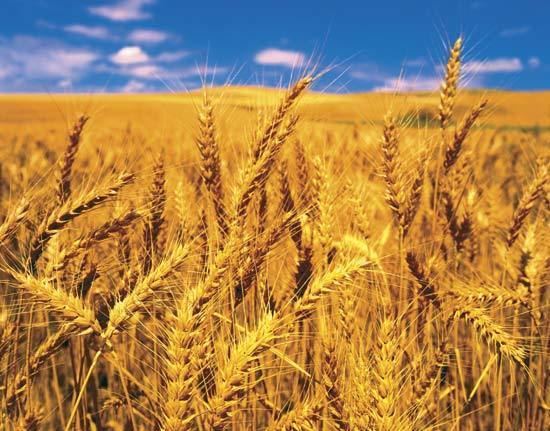
Why whole wheat
Origin
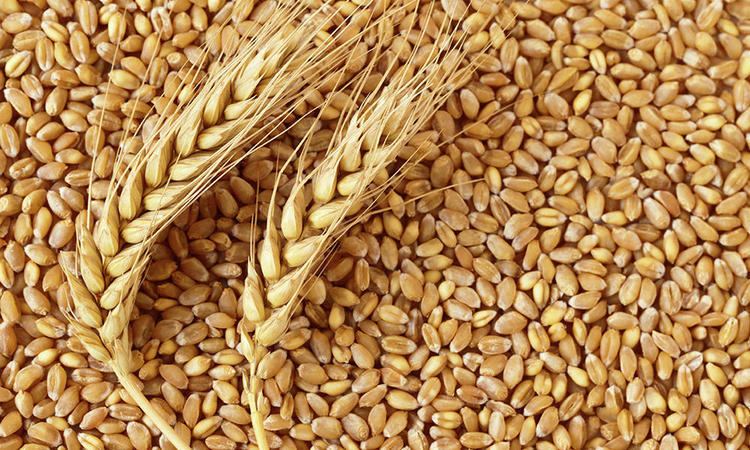
Cultivation and repeated harvesting and sowing of the grains of wild grasses led to the creation of domestic strains, as mutant forms ('sports') of wheat were preferentially chosen by farmers. In domesticated wheat, grains are larger, and the seeds (inside the spikelets) remain attached to the ear by a toughened rachis during harvesting. In wild strains, a more fragile rachis allows the ear to easily shatter and disperse the spikelets. Selection for these traits by farmers might not have been deliberately intended, but simply have occurred because these traits made gathering the seeds easier; nevertheless such 'incidental' selection was an important part of crop domestication. As the traits that improve wheat as a food source also involve the loss of the plant's natural seed dispersal mechanisms, highly domesticated strains of wheat cannot survive in the wild.

Cultivation of wheat began to spread beyond the Fertile Crescent after about 8000 BCE. Jared Diamond traces the spread of cultivated emmer wheat starting in the Fertile Crescent sometime before 8800 BCE. Archaeological analysis of wild emmer indicates that it was first cultivated in the southern Levant with finds dating back as far as 9600 BCE. Genetic analysis of wild einkorn wheat suggests that it was first grown in the Karacadag Mountains in southeastern Turkey. Dated archeological remains of einkorn wheat in settlement sites near this region, including those at Abu Hureyra in Syria, suggest the domestication of einkorn near the Karacadag Mountain Range. With the anomalous exception of two grains from Iraq ed-Dubb, the earliest carbon-14 date for einkorn wheat remains at Abu Hureyra is 7800 to 7500 years BCE.
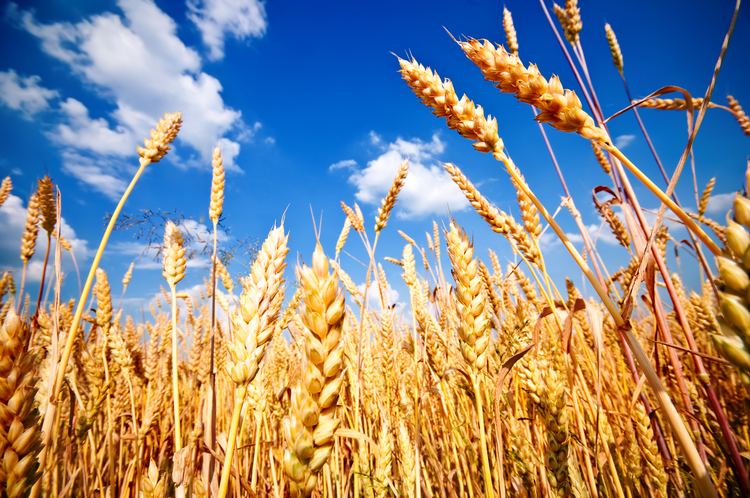
Remains of harvested emmer from several sites near the Karacadag Range have been dated to between 8600 (at Cayonu) and 8400 BCE (Abu Hureyra), that is, in the Neolithic period. With the exception of Iraq ed-Dubb, the earliest carbon-14 dated remains of domesticated emmer wheat were found in the earliest levels of Tell Aswad, in the Damascus basin, near Mount Hermon in Syria. These remains were dated by Willem van Zeist and his assistant Johanna Bakker-Heeres to 8800 BCE. They also concluded that the settlers of Tell Aswad did not develop this form of emmer themselves, but brought the domesticated grains with them from an as yet unidentified location elsewhere.
The cultivation of emmer reached Greece, Cyprus and India by 6500 BCE, Egypt shortly after 6000 BCE, and Germany and Spain by 5000 BCE. "The early Egyptians were developers of bread and the use of the oven and developed baking into one of the first large-scale food production industries." By 3000 BCE, wheat had reached the British Isles and Scandinavia. A millennium later it reached China.
The oldest evidence for hexaploid wheat has been confirmed through DNA analysis of wheat seeds, dating to around 6400-6200 BCE, recovered from Çatalhöyük . The first identifiable bread wheat (Triticum aestivum) with sufficient gluten for yeasted breads has been identified using DNA analysis in samples from a granary dating to approximately 1350 BCE at Assiros in Macedonia.
From Asia, wheat continued to spread throughout Europe. In the British Isles, wheat straw (thatch) was used for roofing in the Bronze Age, and was in common use until the late 19th century.
Farming techniques
Technological advances in soil preparation and seed placement at planting time, use of crop rotation and fertilizers to improve plant growth, and advances in harvesting methods have all combined to promote wheat as a viable crop. Agricultural cultivation using horse collar leveraged plows (at about 3000 BCE) was one of the first innovations that increased productivity. Much later, when the use of seed drills replaced broadcasting sowing of seed in the 18th century, another great increase in productivity occurred.
Yields of pure wheat per unit area increased as methods of crop rotation were applied to long cultivated land, and the use of fertilizers became widespread. Improved agricultural husbandry has more recently included threshing machines and reaping machines (the 'combine harvester'), tractor-drawn cultivators and planters, and better varieties (see Green Revolution and Norin 10 wheat). Great expansion of wheat production occurred as new arable land was farmed in the Americas and Australia in the 19th and 20th centuries.
Genetics
Wheat genetics is more complicated than that of most other domesticated species. Some wheat species are diploid, with two sets of chromosomes, but many are stable polyploids, with four sets of chromosomes (tetraploid) or six (hexaploid).
The presence of certain versions of wheat genes has been important for crop yields. Apart from mutant versions of genes selected in antiquity during domestication, there has been more recent deliberate selection of alleles that affect growth characteristics. Genes for the 'dwarfing' trait, first used by Japanese wheat breeders to produce short-stalked wheat, have had a huge effect on wheat yields worldwide, and were major factors in the success of the Green Revolution in Mexico and Asia, an initiative led by Norman Borlaug. Dwarfing genes enable the carbon that is fixed in the plant during photosynthesis to be diverted towards seed production, and they also help prevent the problem of lodging. 'Lodging' occurs when an ear stalk falls over in the wind and rots on the ground, and heavy nitrogenous fertilization of wheat makes the grass grow taller and become more susceptible to this problem. By 1997, 81% of the developing world's wheat area was planted to semi-dwarf wheats, giving both increased yields and better response to nitrogenous fertilizer.
Wild grasses in the genus Triticum and related genera, and grasses such as rye have been a source of many disease-resistance traits for cultivated wheat breeding since the 1930s.
Heterosis, or hybrid vigor (as in the familiar F1 hybrids of maize), occurs in common (hexaploid) wheat, but it is difficult to produce seed of hybrid cultivars on a commercial scale (as is done with maize) because wheat flowers are perfect and normally self-pollinate. Commercial hybrid wheat seed has been produced using chemical hybridizing agents; these chemicals selectively interfere with pollen development, or naturally occurring cytoplasmic male sterility systems. Hybrid wheat has been a limited commercial success in Europe (particularly France), the United States and South Africa. F1 hybrid wheat cultivars should not be confused with the standard method of breeding inbred wheat cultivars by crossing two lines using hand emasculation, then selfing or inbreeding the progeny many (ten or more) generations before release selections are identified to be released as a variety or cultivar.
Synthetic hexaploids made by crossing the wild goatgrass wheat ancestor Aegilops tauschii and various durum wheats are now being deployed, and these increase the genetic diversity of cultivated wheats.
Stomata (or leaf pores) are involved in both uptake of carbon dioxide gas from the atmosphere and water vapor losses from the leaf due to water transpiration. Basic physiological investigation of these gas exchange processes has yielded valuable carbon isotope based methods that are used for breeding wheat varieties with improved water-use efficiency. These varieties can improve crop productivity in rain-fed dry-land wheat farms.
In 2010, a team of UK scientists funded by BBSRC announced they had decoded the wheat genome for the first time (95% of the genome of a variety of wheat known as Chinese Spring line 42). This genome was released in a basic format for scientists and plant breeders to use but was not a fully annotated sequence which was reported in some of the media.
On 29 November 2012, an essentially complete gene set of bread wheat was published. Random shotgun libraries of total DNA and cDNA from the T. aestivum cv. Chinese Spring (CS42) were sequenced in Roche 454 pyrosequencer using GS FLX Titanium and GS FLX+ platforms to generate 85 Gb of sequence (220 million reads), equivalent to 5X genome coverage and identified between 94,000 and 96,000 genes.
This sequence data provides direct access to about 96,000 genes, relying on orthologous gene sets from other cereals. and represents an essential step towards a systematic understanding of biology and engineering the cereal crop for valuable traits. Its implications in cereal genetics and breeding includes the examination of genome variation, association mapping using natural populations, performing wide crosses and alien introgression, studying the expression and nucleotide polymorphism in transcriptomes, analyzing population genetics and evolutionary biology, and studying the epigenetic modifications. Moreover, the availability of large-scale genetic markers generated through NGS technology will facilitate trait mapping and make marker-assisted breeding much feasible.
Moreover, the data not only facilitate in deciphering the complex phenomena such as heterosis and epigenetics, it may also enable breeders to predict which fragment of a chromosome is derived from which parent in the progeny line, thereby recognizing crossover events occurring in every progeny line and inserting markers on genetic and physical maps without ambiguity. In due course, this will assist in introducing specific chromosomal segments from one cultivar to another. Besides, the researchers had identified diverse classes of genes participating in energy production, metabolism and growth that were probably linked with crop yield, which can now be utilized for the development of transgenic wheat. Thus whole genome sequence of wheat and the availability of thousands of SNPs will inevitably permit the breeders to stride towards identifying novel traits, providing biological knowledge and empowering biodiversity-based breeding.
Plant breeding
In traditional agricultural systems wheat populations often consist of landraces, informal farmer-maintained populations that often maintain high levels of morphological diversity. Although landraces of wheat are no longer grown in Europe and North America, they continue to be important elsewhere. The origins of formal wheat breeding lie in the nineteenth century, when single line varieties were created through selection of seed from a single plant noted to have desired properties. Modern wheat breeding developed in the first years of the twentieth century and was closely linked to the development of Mendelian genetics. The standard method of breeding inbred wheat cultivars is by crossing two lines using hand emasculation, then selfing or inbreeding the progeny. Selections are identified (shown to have the genes responsible for the varietal differences) ten or more generations before release as a variety or cultivar.
The major breeding objectives include high grain yield, good quality, disease and insect resistance and tolerance to abiotic stresses, including mineral, moisture and heat tolerance. The major diseases in temperate environments include the following, arranged in a rough order of their significance from cooler to warmer climates: eyespot, Stagonospora nodorum blotch (also known as glume blotch), yellow or stripe rust, powdery mildew, Septoria tritici blotch (sometimes known as leaf blotch), brown or leaf rust, Fusarium head blight, tan spot and stem rust. In tropical areas, spot blotch (also known as Helminthosporium leaf blight) is also important.
Wheat has also been the subject of mutation breeding, with the use of gamma, x-rays, ultraviolet light, and sometimes harsh chemicals. The varieties of wheat created through these methods are in the hundreds (going as far back as 1960), more of them being created in higher populated countries such as China. Bread wheat with high grain iron and zinc content was developed through gamma radiation breeding. Modern bread wheat varieties have been cross-bred to contain greater amounts of gluten, which affords significant advantages for improving the quality of breads and pastas from a functional point of view. Gluten is appreciated for its unique viscoelastic properties. It gives elasticity to dough and is responsible for dough’s gas-retaining properties.
Hybrid wheat
Because wheat self-pollinates, creating hybrid varieties is extremely labor-intensive; the high cost of hybrid wheat seed relative to its moderate benefits have kept farmers from adopting them widely despite nearly 90 years of effort. F1 hybrid wheat cultivars should not be confused with wheat cultivars deriving from standard plant breeding. Heterosis or hybrid vigor (as in the familiar F1 hybrids of maize) occurs in common (hexaploid) wheat, but it is difficult to produce seed of hybrid cultivars on a commercial scale as is done with maize because wheat flowers are perfect in the botanical sense, meaning they have both male and female parts, and normally self-pollinate. Commercial hybrid wheat seed has been produced using chemical hybridizing agents, plant growth regulators that selectively interfere with pollen development, or naturally occurring cytoplasmic male sterility systems. Hybrid wheat has been a limited commercial success in Europe (particularly France), the United States and South Africa.
Hulled versus free-threshing wheat
The four wild species of wheat, along with the domesticated varieties einkorn, emmer and spelt, have hulls. This more primitive morphology (in evolutionary terms) consists of toughened glumes that tightly enclose the grains, and (in domesticated wheats) a semi-brittle rachis that breaks easily on threshing. The result is that when threshed, the wheat ear breaks up into spikelets. To obtain the grain, further processing, such as milling or pounding, is needed to remove the hulls or husks. In contrast, in free-threshing (or naked) forms such as durum wheat and common wheat, the glumes are fragile and the rachis tough. On threshing, the chaff breaks up, releasing the grains. Hulled wheats are often stored as spikelets because the toughened glumes give good protection against pests of stored grain.
Naming
There are many botanical classification systems used for wheat species, discussed in a separate article on wheat taxonomy. The name of a wheat species from one information source may not be the name of a wheat species in another.
Within a species, wheat cultivars are further classified by wheat breeders and farmers in terms of:
Major cultivated species of wheat
Hexaploid species
Tetraploid species
Diploid species
Classes used in the United States
The classes used in the United States are:
Red wheats may need bleaching; therefore, white wheats usually command higher prices than red wheats on the commodities market.
As a food
Raw wheat can be ground into flour or, using hard durum wheat only, can be ground into semolina; germinated and dried creating malt; crushed or cut into cracked wheat; parboiled (or steamed), dried, crushed and de-branned into bulgur also known as groats. If the raw wheat is broken into parts at the mill, as is usually done, the outer husk or bran can be used several ways. Wheat is a major ingredient in such foods as bread, porridge, crackers, biscuits, Muesli, pancakes, pies, pastries, cakes, cookies, muffins, rolls, doughnuts, gravy, boza (a fermented beverage), and breakfast cereals.
In manufacturing wheat products, gluten is valuable to impart viscoelastic functional qualities in dough, enabling the preparation of diverse nutritious foods such as breads, noodles, and pasta that facilitate wheat consumption.
Nutrition
In 100 grams, wheat provides 327 calories and is a rich source (20% or more of the Daily Value, DV) of multiple essential nutrients, such as protein, dietary fiber, manganese, phosphorus and niacin (table). Several B vitamins and other dietary minerals are in significant content. Wheat is 13% water, 71% carbohydrates, and 1.5% fat. Its 13% protein content is comprised mostly of gluten as 75-80% of total wheat protein, which upon digestion, contributes amino acids for human nutrition.
Ch. = Choline; Ca = Calcium; Fe = Iron; Mg = Magnesium; P = Phosphorus; K = Potassium; Na = Sodium; Zn = Zinc; Cu = Copper; Mn = Manganese; Se = Selenium; %DV = % daily value i.e. % of DRI (Dietary Reference Intake) Note: All nutrient values including protein and fiber are in %DV per 100 grams of the food item. Significant values are highlighted in light Gray color and bold letters. Cooking reduction = % Maximum typical reduction in nutrients due to boiling without draining for ovo-lacto-vegetables group Q = Quality of Protein in terms of completeness without adjusting for digestability.
100 g (3.5 oz) of hard red winter wheat contain about 12.6 g (0.44 oz) of protein, 1.5 g (0.053 oz) of total fat, 71 g (2.5 oz) of carbohydrate (by difference), 12.2 g (0.43 oz) of dietary fiber, and 3.2 mg (0.00011 oz) of iron (17% of the daily requirement); the same weight of hard red spring wheat contains about 15.4 g (0.54 oz) of protein, 1.9 g (0.067 oz) of total fat, 68 g (2.4 oz) of carbohydrate (by difference), 12.2 g (0.43 oz) of dietary fiber, and 3.6 mg (0.00013 oz) of iron (20% of the daily requirement).
Worldwide consumption
Wheat is grown on more than 218,000,000 hectares (540,000,000 acres), larger than for any other crop. World trade in wheat is greater than for all other crops combined. With rice, wheat is the world's most favored staple food. It is a major diet component because of the wheat plant's agronomic adaptability with the ability to grow from near arctic regions to equator, from sea level to plains of Tibet, approximately 4,000 m (13,000 ft) above sea level. In addition to agronomic adaptability, wheat offers ease of grain storage and ease of converting grain into flour for making edible, palatable, interesting and satisfying foods. Wheat is the most important source of carbohydrate in a majority of countries.
The most common forms of wheat are white and red wheat. However, other natural forms of wheat exist. Other commercially minor but nutritionally promising species of naturally evolved wheat species include black, yellow and blue wheat.
Health effects
Consumed worldwide by billions of people, wheat is a significant food for human nutrition, particularly in the least developed countries where wheat products are primary foods. When eaten as the whole grain, wheat is a healthy food source of multiple nutrients and dietary fiber recommended for children and adults in several daily servings amounting to about one third of total food intake.
As a common component of breakfast cereals, whole wheat is associated with improved micronutrient intake and lower risk of several diseases. Its effects on gastrointestinal health, risk of obesity and cognition need further evaluation. By supplying high dietary fiber content, whole wheat in the diet contributes toward lowering the risk of multiple diseases, including coronary heart disease, stroke, cancer and type 2 diabetes, with lower all-cause mortality.
Manufacturers of foods containing wheat as a whole grain in specified amounts are allowed a health claim for marketing purposes in the United States, stating: "low fat diets rich in fiber-containing grain products, fruits, and vegetables may reduce the risk of some types of cancer, a disease associated with many factors" and "diets low in saturated fat and cholesterol and rich in fruits, vegetables, and grain products that contain some types of dietary fiber, particularly soluble fiber, may reduce the risk of heart disease, a disease associated with many factors". Dietary fiber may also help people feel full and therefore help with a healthy weight. Further, wheat is a major source for natural and biofortified nutrient supplementation, including dietary fiber, protein and dietary minerals.
Concerns
In genetically susceptible people, gluten – a major part of wheat protein – can trigger coeliac disease. Coeliac disease affects about 1% of the general population in developed countries. There is evidence that most cases remain undiagnosed and untreated. The only known effective treatment is a strict lifelong gluten-free diet.
While coeliac disease is caused by a reaction to wheat proteins, it is not the same as a wheat allergy. Other diseases triggered by eating gluten are non-coeliac gluten sensitivity, (estimated to affect 0.5% to 13% of the general population), gluten ataxia and dermatitis herpetiformis.
Comparison with other staple foods
The following table shows the nutrient content of wheat and other major staple foods in a raw form.
Raw forms of these staples, however, are not edible and cannot be digested. These must be sprouted, or prepared and cooked as appropriate for human consumption. In sprouted or cooked form, the relative nutritional and anti-nutritional contents of each of these grains is remarkably different from that of raw form of these grains reported in this table.
In cooked form, the nutrition value for each staple depends on the cooking method (for example: baking, boiling, steaming, frying, etc.).
Commercial use
Harvested wheat grain that enters trade is classified according to grain properties for the purposes of the commodity markets. Wheat buyers use these to decide which wheat to buy, as each class has special uses, and producers use them to decide which classes of wheat will be most profitable to cultivate.
Wheat is widely cultivated as a cash crop because it produces a good yield per unit area, grows well in a temperate climate even with a moderately short growing season, and yields a versatile, high-quality flour that is widely used in baking. Most breads are made with wheat flour, including many breads named for the other grains they contain, for example, most rye and oat breads. The popularity of foods made from wheat flour creates a large demand for the grain, even in economies with significant food surpluses.
In recent years, low international wheat prices have often encouraged farmers in the United States to change to more profitable crops. In 1998, the price at harvest of a 60 pounds (27 kg) bushel was $2.68 per. Some information providers, following CBOT practice, quote the wheat market in per ton denomination. A USDA report revealed that in 1998, average operating costs were $1.43 per bushel and total costs were $3.97 per bushel. In that study, farm wheat yields averaged 41.7 bushels per acre (2.2435 metric ton/hectare), and typical total wheat production value was $31,900 per farm, with total farm production value (including other crops) of $173,681 per farm, plus $17,402 in government payments. There were significant profitability differences between low- and high-cost farms, mainly due to crop yield differences, location, and farm size.
Production and consumption
In 2016, global wheat production was 749 million tonnes. Wheat is the primary food staple in North Africa and the Middle East, and is growing in uses in Asia. Unlike rice, wheat production is more widespread globally, though 47% of the world total in 2014 was produced by just four countries – China, India, Russia and the United States (table).
Historical factors
In the 20th century, global wheat output expanded by about 5-fold, but until about 1955 most of this reflected increases in wheat crop area, with lesser (about 20%) increases in crop yields per unit area. After 1955 however, there was a ten-fold increase in the rate of wheat yield improvement per year, and this became the major factor allowing global wheat production to increase. Thus technological innovation and scientific crop management with synthetic nitrogen fertilizer, irrigation and wheat breeding were the main drivers of wheat output growth in the second half of the century. There were some significant decreases in wheat crop area, for instance in North America.
Better seed storage and germination ability (and hence a smaller requirement to retain harvested crop for next year's seed) is another 20th century technological innovation. In Medieval England, farmers saved one-quarter of their wheat harvest as seed for the next crop, leaving only three-quarters for food and feed consumption. By 1999, the global average seed use of wheat was about 6% of output.
Several factors are currently slowing the rate of global expansion of wheat production: population growth rates are falling while wheat yields continue to rise, and the better economic profitability of other crops such as soybeans and maize, linked with investment in modern genetic technologies, has promoted shifts to other crops.
Farming systems
In 2014, the most productive crop yields for wheat were in Ireland, producing 10 tonnes per hectare. In addition to gaps in farming system technology and knowledge, some large wheat grain producing countries have significant losses after harvest at the farm and because of poor roads, inadequate storage technologies, inefficient supply chains and farmers' inability to bring the produce into retail markets dominated by small shopkeepers. Various studies in India, for example, have concluded that about 10% of total wheat production is lost at farm level, another 10% is lost because of poor storage and road networks, and additional amounts lost at the retail level.
In the Punjab region of India and Pakistan, as well as North China, irrigation has been a major contributor to increased grain output. More widely over the last 40 years, a massive increase in fertilizer use together with the increased availability of semi-dwarf varieties in developing countries, has greatly increased yields per hectare. In developing countries, use of (mainly nitrogenous) fertilizer increased 25-fold in this period. However, farming systems rely on much more than fertilizer and breeding to improve productivity. A good illustration of this is Australian wheat growing in the southern winter cropping zone, where, despite low rainfall (300 mm), wheat cropping is successful even with relatively little use of nitrogenous fertilizer. This is achieved by 'rotation cropping' (traditionally called the ley system) with leguminous pastures and, in the last decade, including a canola crop in the rotations has boosted wheat yields by a further 25%. In these low rainfall areas, better use of available soil-water (and better control of soil erosion) is achieved by retaining the stubble after harvesting and by minimizing tillage.
Geographical variation
There are substantial differences in wheat farming, trading, policy, sector growth, and wheat uses in different regions of the world. The largest exporters of wheat in 2013 were, in order of exported quantities: United States (33.2 million tonnes), Canada (19.8 million tonnes), France (19.6 million tonnes), Australia (18 million tonnes), and the Russian Federation (13.8 million tonnes). The largest importers of wheat in 2013 were, in order of imported quantities: Egypt (10.3 million tonnes), Brazil (7.3 million tonnes), Indonesia (6.7 million tonnes), Algeria (6.3 million tonnes) and Japan (6.2 million tonnes).
In the rapidly developing countries of Asia and Africa, westernization of diets associated with increasing prosperity is leading to growth in per capita demand for wheat at the expense of the other food staples.
In the past, there has been significant governmental intervention in wheat markets, such as price supports in the US and farm payments in the EU. In the EU, these subsidies have encouraged heavy use of fertilizer inputs with resulting high crop yields. In Australia and Argentina, direct government subsidies are much lower.
Most productive
The average annual world farm yield for wheat in 2014 was 3.3 tonnes per hectare (330 grams per square meter). Ireland wheat farms were the most productive in 2014, with a nationwide average of 10.0 tonnes per hectare, followed by the Netherlands (9.2), and Germany, New Zealand and the United Kingdom (each with 8.6).
Futures contracts
Wheat futures are traded on the Chicago Board of Trade, Kansas City Board of Trade, and Minneapolis Grain Exchange, and have delivery dates in March (H), May (K), July (N), September (U), and December (Z).
Crop development
Wheat normally needs between 110 and 130 days between sowing and harvest, depending upon climate, seed type, and soil conditions (winter wheat lies dormant during a winter freeze). Optimal crop management requires that the farmer have a detailed understanding of each stage of development in the growing plants. In particular, spring fertilizers, herbicides, fungicides, and growth regulators are typically applied only at specific stages of plant development. For example, it is currently recommended that the second application of nitrogen is best done when the ear (not visible at this stage) is about 1 cm in size (Z31 on Zadoks scale). Knowledge of stages is also important to identify periods of higher risk from the climate. For example, pollen formation from the mother cell, and the stages between anthesis and maturity are susceptible to high temperatures, and this adverse effect is made worse by water stress. Farmers also benefit from knowing when the 'flag leaf' (last leaf) appears, as this leaf represents about 75% of photosynthesis reactions during the grain filling period, and so should be preserved from disease or insect attacks to ensure a good yield.
Several systems exist to identify crop stages, with the Feekes and Zadoks scales being the most widely used. Each scale is a standard system which describes successive stages reached by the crop during the agricultural season.
Diseases
There are many wheat diseases, mainly caused by fungi, bacteria, and viruses. Plant breeding to develop new disease-resistant varieties, and sound crop management practices are important for preventing disease. Fungicides, used to prevent the significant crop losses from fungal disease, can be a significant variable cost in wheat production. Estimates of the amount of wheat production lost owing to plant diseases vary between 10–25% in Missouri. A wide range of organisms infect wheat, of which the most important are viruses and fungi.
The main wheat-disease categories are:
Pests
Wheat is used as a food plant by the larvae of some Lepidoptera (butterfly and moth) species including the flame, rustic shoulder-knot, setaceous Hebrew character and turnip moth. Early in the season, many species of birds, including the long-tailed widowbird, and rodents feed upon wheat crops. These animals can cause significant damage to a crop by digging up and eating newly planted seeds or young plants. They can also damage the crop late in the season by eating the grain from the mature spike. Recent post-harvest losses in cereals amount to billions of dollars per year in the United States alone, and damage to wheat by various borers, beetles and weevils is no exception. Rodents can also cause major losses during storage, and in major grain growing regions, field mice numbers can sometimes build up explosively to plague proportions because of the ready availability of food. To reduce the amount of wheat lost to post-harvest pests, Agricultural Research Service scientists have developed an "insect-o-graph," which can detect insects in wheat that are not visible to the naked eye. The device uses electrical signals to detect the insects as the wheat is being milled. The new technology is so precise that it can detect 5-10 infested seeds out of 300,000 good ones. Tracking insect infestations in stored grain is critical for food safety as well as for the marketing value of the crop.
